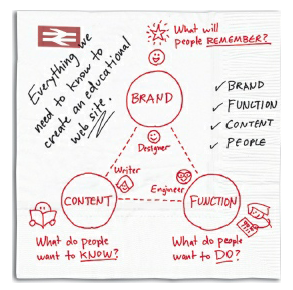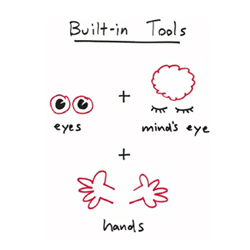 I remember years ago, when creating the Brasov office together with Codrut, the list we made before we go to shop office furniture. He said “we need a whiteboard”. And i replied then “two whiteboards”. We smiled, and concluded to take three whiteboards. Finally we bought five whiteboards plus two pin boards as a bonus …
I remember years ago, when creating the Brasov office together with Codrut, the list we made before we go to shop office furniture. He said “we need a whiteboard”. And i replied then “two whiteboards”. We smiled, and concluded to take three whiteboards. Finally we bought five whiteboards plus two pin boards as a bonus …
Why have we done that ? Because we both are visual persons and we like to draw. People, leaves, concepts, strategies, a hall of fame, hundreds of websites and sometimes funny faces … All day long we live connected to our markers.
I will brief you about making (create and structure) outstanding visual pitch presentations, analyzing Dan Roam’s vision exposed in the book “The back of the Napkin“. A very-very interesting book in terms of business structuring and visual. What Dan doesn’t say is that he is a very good analyst and business consultant, and he “sees” things a little more than average. Nevertheless, remember this is an American book and is created in the spirit of “anyone can make it” Ratatouille spirit … There are some things you do currently in your life, instinctive. Dan Roam puts a light, in an empiric-but-funny way, on the visual process. A book you should buy and read.
(all the images below have Dan Roam’s copywrite)
To create outstanding visual pitch presentations
You need to understand the way people visual think
to create the MATRIX of Visual Thinking.
This matrix is composed of:
A. Three basic visual thinking tools: (1) our eyes, (2) our mind’s eye, and (3) our hand-eye coordination
B. Four steps of the visual thinking process, four steps we already know how to do: (1) look, (2) see, (3) imagine, and (4) show.
C. Five SQVID questions that help us open our mind’s eye: (1) simple or elaborate, (2) qualitative or quantitative, (3) vision or execution, (4) individual or comparison, (5) change or status quo?
D. Six ways we see, and the six corresponding ways we show: (1) who/what, (2) how much, (3) where, (4) when, (5) how, and (6) why
EXAMPLE of Visual Thinking :
What people want to do (or what we want them to do) determines function; what people want to KNOW (or what we want them to know) determines content; and what we want them to REMEMBER determines the brand. If our research tells us what to put in those three circles, then it’s our own Web site team who will create it. Our engineers build the functional components; our writers define, write, and edit the content; and our designers create an experience that will be memorable.

Brief – here is what you should remember to create outstanding visual pitch presentations
A. Three basic visual thinking tools: (1) our eyes, (2) our mind’s eye, and (3) our hand-eye coordination


B. Four steps of the visual thinking process, four steps we already know how to do: (1) look, (2) see, (3) imagine, and (4) show.


C. Five SQVID questions that help us open our mind’s eye: (1) simple or elaborate, (2) qualitative or quantitative, (3) vision or execution, (4) individual or comparison, (5) change or status quo?






D. Six ways we see, and the six corresponding ways we show: (1) who/what, (2) how much, (3) where, (4) when, (5) how, and (6) why









Recommendation : buy Dan Roam’s “The back of the Napkin“



Leave a Reply